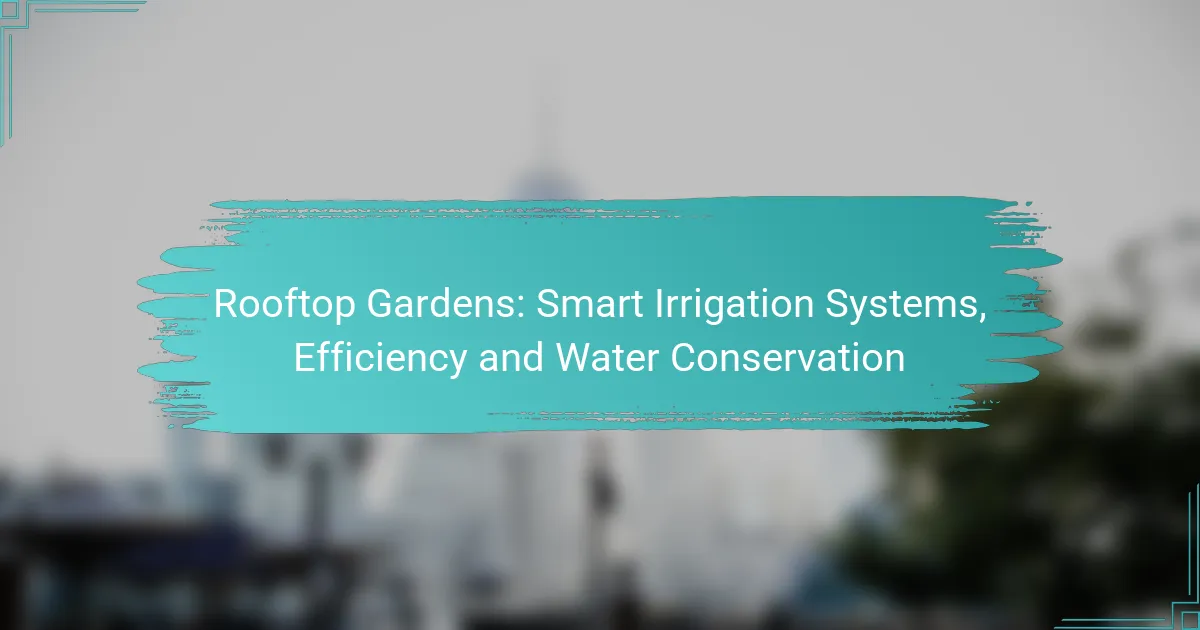Rooftop gardens are increasingly benefiting from smart irrigation systems that enhance water conservation and promote plant health. By automating watering based on specific plant needs and environmental conditions, these systems optimize water usage while minimizing waste, leading to cost efficiency and healthier plants.
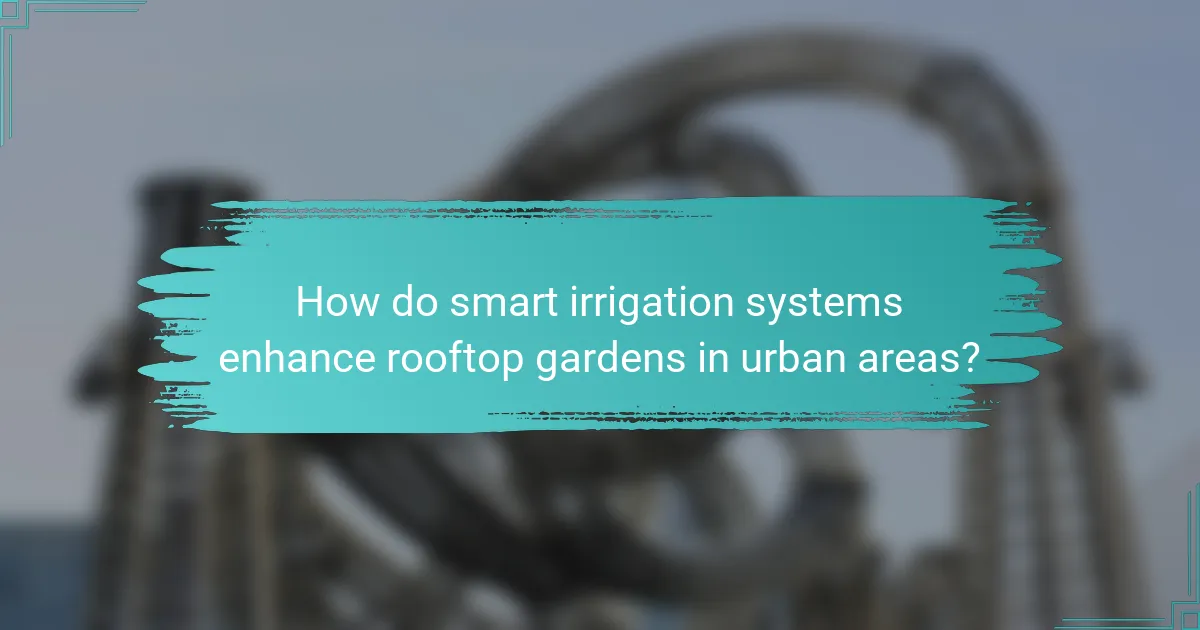
How do smart irrigation systems enhance rooftop gardens in urban areas?
Smart irrigation systems significantly improve rooftop gardens by optimizing water usage and promoting plant health. These systems utilize technology to automate watering, ensuring that plants receive the right amount of moisture based on their specific needs and environmental conditions.
Automated watering schedules
Automated watering schedules allow rooftop gardens to receive consistent irrigation without manual intervention. By programming watering times and durations, gardeners can ensure that plants are watered during optimal periods, such as early morning or late evening, reducing evaporation losses.
For effective scheduling, consider the types of plants in your garden and their water requirements. A common approach is to set watering intervals based on seasonal changes, adjusting frequency during hotter months when plants may need more moisture.
Soil moisture sensors
Soil moisture sensors play a crucial role in smart irrigation by providing real-time data on soil conditions. These sensors detect moisture levels and communicate with the irrigation system to adjust watering accordingly, preventing overwatering or underwatering.
When selecting soil moisture sensors, look for models that offer reliable readings and can integrate with your irrigation system. Regular maintenance and calibration of these sensors are essential to ensure accurate performance and optimal plant health.
Weather-responsive adjustments
Weather-responsive adjustments enhance smart irrigation systems by taking local weather conditions into account. These systems can modify watering schedules based on rainfall forecasts or current humidity levels, conserving water and reducing costs.
To implement weather-responsive adjustments, consider using a system that connects to local weather stations or utilizes online weather data. This feature can significantly lower water usage, potentially saving up to 30% compared to traditional irrigation methods during rainy seasons.

What are the benefits of using smart irrigation systems?
Smart irrigation systems offer significant advantages, including enhanced water conservation, cost efficiency, and improved plant health. By utilizing technology to monitor and adjust watering schedules, these systems ensure that plants receive the optimal amount of water while minimizing waste.
Water conservation
Smart irrigation systems are designed to use water more efficiently, which is crucial in areas facing water scarcity. These systems often incorporate sensors that detect soil moisture levels, allowing for precise watering only when necessary. As a result, users can reduce water consumption by up to 50% compared to traditional irrigation methods.
Additionally, many smart systems can integrate weather data to adjust watering schedules based on rainfall or temperature changes. This proactive approach prevents overwatering and helps maintain a sustainable water supply.
Cost efficiency
Investing in smart irrigation systems can lead to significant cost savings over time. By reducing water usage, homeowners and businesses can lower their water bills, which is especially beneficial in regions with high water rates. The initial investment in smart technology is often recouped within a few years through these savings.
Moreover, many systems come with features that allow users to monitor their water usage and identify leaks or inefficiencies. This capability can prevent costly repairs and further enhance overall cost efficiency.
Improved plant health
Smart irrigation systems contribute to healthier plants by delivering the right amount of water at the right time. This targeted approach prevents issues such as root rot and fungal diseases that can arise from overwatering. Healthy plants are more resilient and can better withstand environmental stressors.
Furthermore, these systems can be programmed to cater to the specific needs of different plant species, ensuring that each type receives optimal care. This tailored watering strategy promotes robust growth and vibrant landscapes.
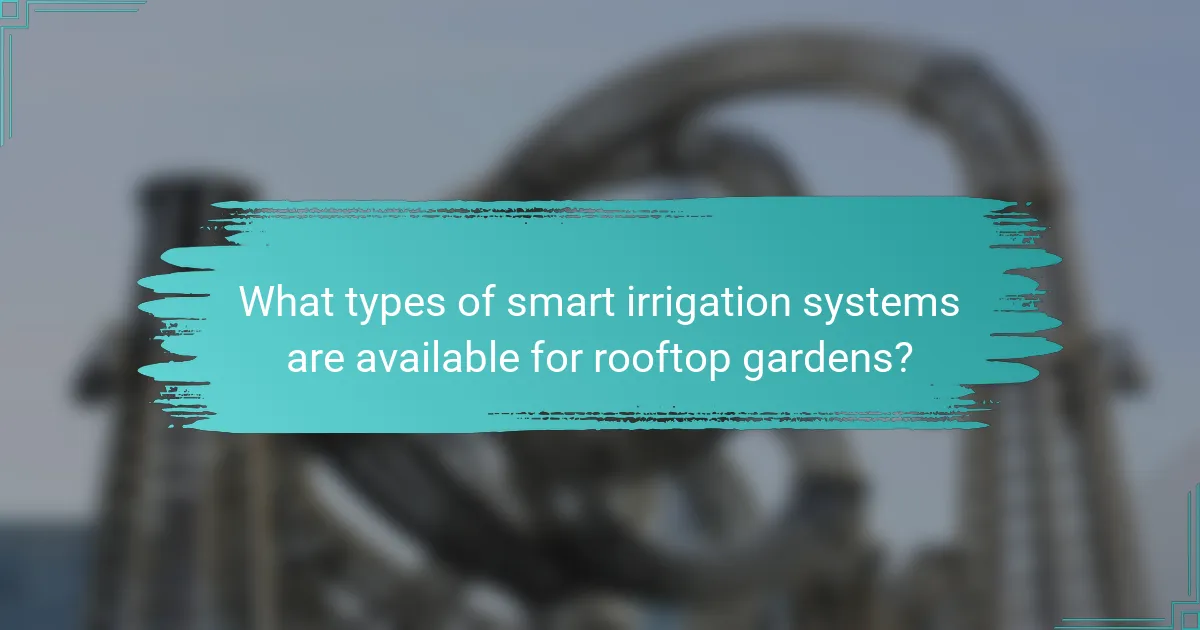
What types of smart irrigation systems are available for rooftop gardens?
Rooftop gardens can utilize various smart irrigation systems, each designed to optimize water usage and promote plant health. The most common types include drip irrigation, sprinkler systems, and subsurface irrigation, each offering unique benefits and considerations for urban gardening.
Drip irrigation systems
Drip irrigation systems deliver water directly to the plant roots through a network of tubing and emitters. This method minimizes water waste by reducing evaporation and runoff, making it highly efficient for rooftop gardens. It’s particularly suitable for plants that require consistent moisture, such as herbs and vegetables.
When setting up a drip system, consider the layout of your garden and the specific water needs of your plants. Regular maintenance is essential to prevent clogging of emitters, which can disrupt water flow. A timer can enhance efficiency by automating watering schedules based on weather conditions.
Sprinkler systems
Sprinkler systems use overhead spray to distribute water across a larger area, making them ideal for covering extensive rooftop gardens. They can be adjusted to different spray patterns and distances, allowing flexibility in watering various plant types. However, they may lead to higher water loss through evaporation, especially in sunny climates.
For rooftop applications, consider using low-pressure, rotating sprinklers that provide even coverage while conserving water. Installing a rain sensor can help prevent unnecessary watering during wet weather, ensuring efficient water use. Regularly check for leaks or blockages to maintain optimal performance.
Subsurface irrigation
Subsurface irrigation systems deliver water below the soil surface, directly to the root zone, which significantly reduces evaporation and runoff. This method is particularly effective for deep-rooted plants and can be beneficial in urban settings where water conservation is critical.
Implementing a subsurface system requires careful planning and installation, as it involves burying tubing or porous materials in the soil. Monitoring soil moisture levels is crucial to avoid overwatering. This system can be combined with sensors to automate watering based on real-time moisture data, enhancing efficiency and plant health.
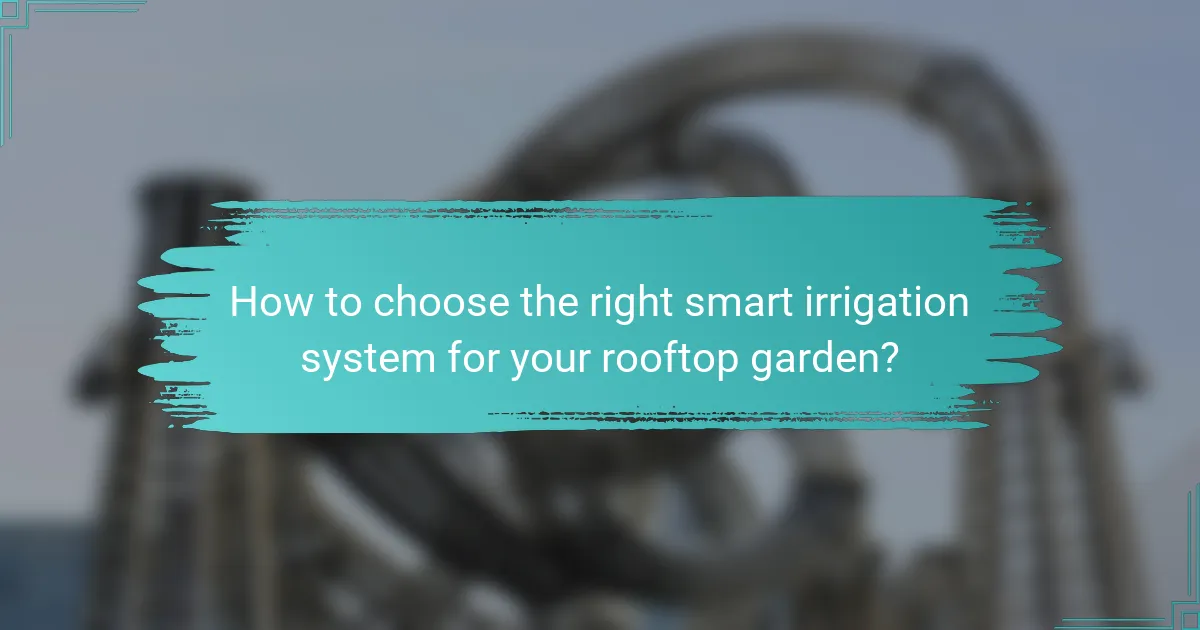
How to choose the right smart irrigation system for your rooftop garden?
Choosing the right smart irrigation system for your rooftop garden involves assessing your garden’s size, the types of plants you are growing, and the local climate conditions. A well-selected system can optimize water usage, promote healthy plant growth, and conserve resources effectively.
Assessing garden size
The size of your rooftop garden significantly influences the type of smart irrigation system you should choose. For smaller gardens, a simple drip irrigation system may suffice, while larger spaces may require more complex setups with multiple zones. Measure your garden area to determine the necessary coverage and water flow requirements.
Consider the layout as well; irregular shapes may need customized solutions. Systems that allow for scalability can be beneficial if you plan to expand your garden in the future.
Evaluating plant types
Your choice of plants will dictate the watering needs and the type of irrigation system that works best. For instance, drought-resistant plants require less frequent watering compared to tropical varieties. Grouping plants with similar water needs can enhance efficiency and simplify irrigation management.
Research the specific watering requirements for each plant type in your garden. Some smart systems allow for tailored watering schedules based on plant species, which can help maintain optimal health and growth.
Considering local climate
Local climate plays a crucial role in determining the right smart irrigation system. Areas with high temperatures and low rainfall may benefit from systems that provide more frequent watering, while regions with cooler, wetter climates can afford to use less water. Understanding seasonal variations is essential for effective irrigation planning.
Additionally, consider local regulations regarding water usage and conservation. Some regions may have restrictions on irrigation during certain times or require specific technologies to minimize water waste.
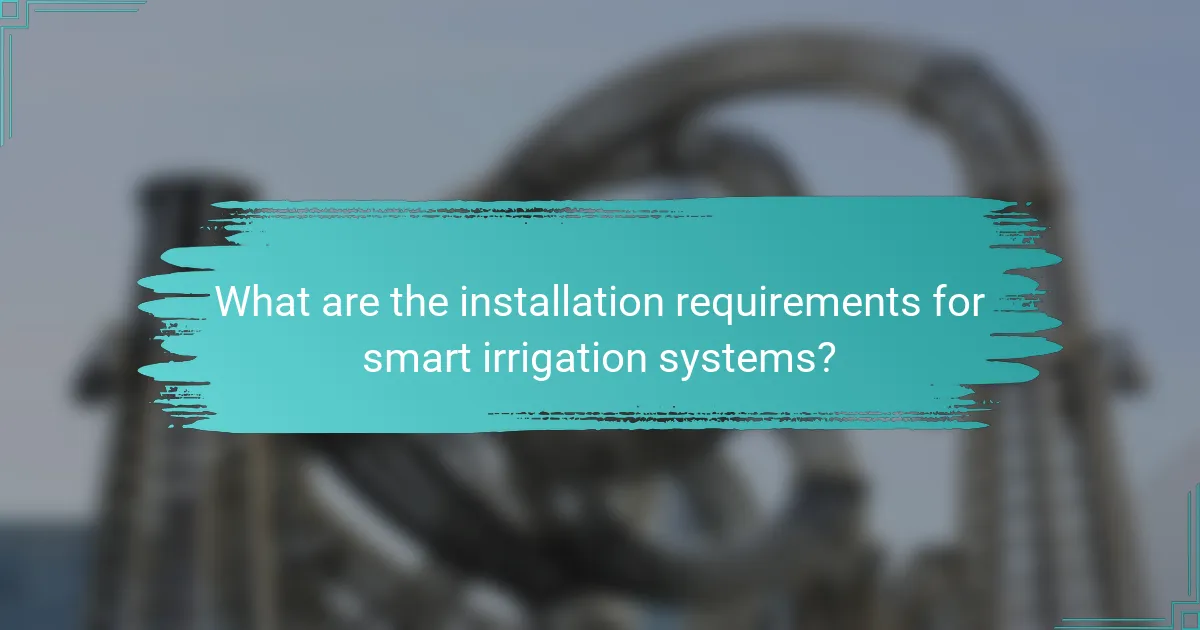
What are the installation requirements for smart irrigation systems?
Installing smart irrigation systems requires careful consideration of several key factors, including water source accessibility, electrical supply needs, and compatibility with existing infrastructure. These elements ensure efficient operation and optimal water conservation.
Water source accessibility
Access to a reliable water source is crucial for any smart irrigation system. This could be municipal water, a well, or a rainwater harvesting system. Evaluate the proximity and pressure of the water source to ensure it meets the system’s requirements.
Consider the local regulations regarding water usage, especially in areas prone to drought. Understanding these regulations can help in selecting the right system and avoiding potential fines.
Electrical supply needs
Smart irrigation systems often require a stable electrical supply to operate sensors, controllers, and valves. Check if there is an existing electrical outlet nearby or if additional wiring is needed. Battery-operated systems are also available for areas without easy access to power.
Ensure that the electrical supply meets the voltage and amperage requirements of the system. Consulting with a licensed electrician can help avoid any installation issues.
System compatibility with existing infrastructure
Compatibility with your current irrigation setup is essential for a smooth installation. Assess whether the smart system can integrate with existing pipes, valves, and controllers. This can save time and reduce costs by minimizing the need for extensive modifications.
Research different brands and models to find one that aligns with your current infrastructure. Many manufacturers provide compatibility charts or guides to assist in this process.
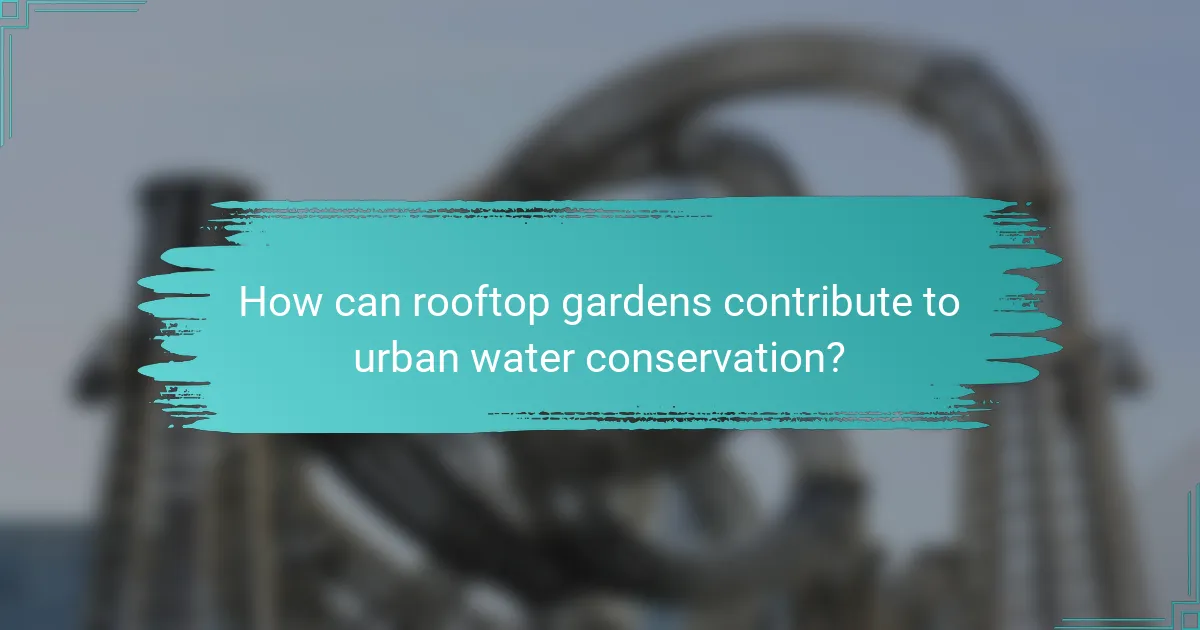
How can rooftop gardens contribute to urban water conservation?
Rooftop gardens play a significant role in urban water conservation by absorbing rainwater, reducing runoff, and promoting efficient water use. These green spaces help manage stormwater, decrease the burden on drainage systems, and enhance the overall sustainability of urban environments.
Reducing runoff
Rooftop gardens effectively reduce runoff by capturing rainwater, allowing it to be absorbed by the soil and plants. This process minimizes the volume of water that flows into storm drains, which can lead to flooding and water pollution in urban areas.
By retaining water, rooftop gardens can lower the risk of combined sewer overflows, especially in cities with aging infrastructure. Implementing a green roof can decrease runoff by 50-90% during rain events, depending on the design and plant selection.
Enhancing local biodiversity
Rooftop gardens contribute to local biodiversity by providing habitats for various species, including birds, insects, and pollinators. These green spaces create new ecosystems in urban settings, where natural habitats are often limited.
Incorporating native plants into rooftop gardens can attract local wildlife and promote ecological balance. Additionally, these gardens can serve as stepping stones for species migration, helping to maintain biodiversity in densely populated areas.
